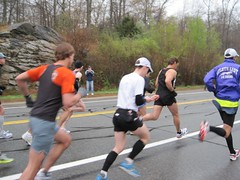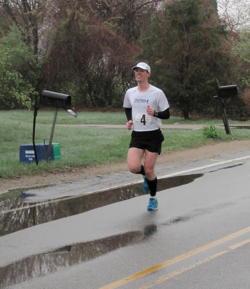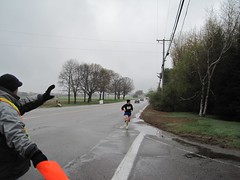Last week I ran the first Exeter Marathon in Rhode Island. Exeter was a little different than most races because not only was there a qualifying standard that you needed to meet in order to run, but it was a strict one; if you didn’t make the standard, then you weren’t allowed to register. The standards were 5 minutes faster than the equivalent Boston qualifying time across the board, including the 59 second lee-way that’s afforded to the runners.
That meant that the field was a relatively experienced group, although there were at least 1 or 2 runners who were only running their second marathon. Because it was only 2 days before the Boston Marathon and was so close, quite a few people took the opportunity to knock out 2 marathons in the same weekend, although I contented myself with watching Boston.
The Course
 The proposed course changed quite a bit over the past few months since the race was conceived, due to construction and storm damage. The general idea for the final race course was to be an out and back, with each mile marker lining up on the way back with it’s corresponding mile marker on the way out.
The proposed course changed quite a bit over the past few months since the race was conceived, due to construction and storm damage. The general idea for the final race course was to be an out and back, with each mile marker lining up on the way back with it’s corresponding mile marker on the way out.
This meant that miles 1 and 25 were at the same point, 2 and 24, 10 and 16, etc. The finish line was 385 yards further down the road past the start line, which corresponded with mile 26. It was nice to have an idea about what to expect, although had there been more people in the race then it would have been a little congested in areas where you passed people going in the opposite direction.
I don’t believe that this course will be used again, however, and it worked out fine for the small numbers that were in the race.
 The first few miles (and consequently the last few miles) along with the middle of the race were on smaller back roads without a lot of traffic, but a large portion of the race took place running south on Route 2 in the first half and then north again in the second half.
The first few miles (and consequently the last few miles) along with the middle of the race were on smaller back roads without a lot of traffic, but a large portion of the race took place running south on Route 2 in the first half and then north again in the second half.
I’m not generally a big fan of running along larger roads with a lot of traffic, although I am sure that it was relatively light given that it was a Saturday morning.
There was one accident along the course that we had to run around on the way out, although it had been cleared by the time we came back through.
 The turnaround points in the middle of the race were a little inconvenient; there were 2 places where you had to run around a cone and head back the way you came. A few of the guys ahead of me turned back early when they saw the half marathon marker before realizing their mistake and had to turn around again in order to head over to the cone.
The turnaround points in the middle of the race were a little inconvenient; there were 2 places where you had to run around a cone and head back the way you came. A few of the guys ahead of me turned back early when they saw the half marathon marker before realizing their mistake and had to turn around again in order to head over to the cone.
The mile markers were very well marked; there was a sandwich board at each mile with the corresponding mile marker, as well as a yellow hash mark every half mile and a white hash mark at the halfway point.
At least, I assume that there were hash marks every mile, since before the race it was mentioned that there was and the few times I did look down I noticed them. I don’t generally watch the road right in front of me when I am running so I went past most of them without noticing.
The course is relatively flat, although what small hills there were seemed to be a little more difficult given the breeze coming over them on the way back in the second half of the race. Elevation runs between 82 feet above sea level to 250 feet above sea level, with a total ascent of 575 feet and a net descent of 17 feet as the finish line is a bit downhill from the starting line.
My Race
I was trying something new for this race. Running the race seemed a no-brainer given the relatively low cost for a marathon (only $40, 40% of which went towards the prize purse) and the fact that I was going to be over halfway there anyway for the weekend since I head down to Massachusetts every Patriot’s Day Weekend anyway. I decided that I was finally going to give the Run-Walk-Run race strategy a try since I’d been wanting to test it out for a few years now.

My strategy was to walk for about 35 steps every mile. That equates to about 15 seconds, but doesn’t require me to actually stare at my watch to time myself and made it easier to put them in where it was convenient rather than being stuck listening for my watch to beep at me.
In training, I was able to consistently go 38 steps in 15 seconds, which is how I arrived at 35 for during the race. By counting 35 steps, I accounted for my deceleration and acceleration without going beyond the 15 seconds allocated to walking, and it’s a lot easier to count to 35 than 38 for me. (I count to 20 and then to 15.) I’d only run up to 10 miles in training while testing the run-walk-run method so I didn’t know how tough it would become as I began to get tired later in the race.
 After 20 miles, I took my last walk break and then ran the rest of the way in. Because of the quality of the competition, I basically ran the entire race alone except when passing a volunteer, spectator, or runner going in the opposite direction. The eventual winner was off on his own right off the bat, but I ran the first mile with the rest of the guys that beat me until it was time for my first walk break.
After 20 miles, I took my last walk break and then ran the rest of the way in. Because of the quality of the competition, I basically ran the entire race alone except when passing a volunteer, spectator, or runner going in the opposite direction. The eventual winner was off on his own right off the bat, but I ran the first mile with the rest of the guys that beat me until it was time for my first walk break.
After that, they steadily increased their lead on me each mile for the next 10 or 15 miles before I started to catch up to a few of them again. One person did drop out around mile 19; he said he was okay but I think that I heard later that he had suffered from hypothermia.
There were a few guys about half a minute ahead of me at the finish line that I couldn’t quite catch up to, one of whom went to the same high school and college that I did (and ran for the same teams) although he is younger enough than me that this was the first time I’ve met him in person.
Going into the race, my training and level of fitness seemed pretty similar to how I felt when I ran my 3 hour to 3:10 marathons about 5 or 6 years ago. Realistically, I felt as though I were in shape to run a 2:54 or so, which is why I predicted a 2:53-2:55.
I crossed the finish line in 8th place of 54 finishers in 2:50:26. I don’t know whether that extra 3½ minutes faster that I ran was due to the run-walk-run, but I’d call the experiment a success and think that it is probably worth trying the strategy again when I am in better shape. If I can cut 3 or 4 minutes off of my PR while I am in similar shape then that would finally get me below that 2:40 barrier.
Volunteers and Spectators
There were almost as many volunteers as there were runners, I would guess. If you count seeing the same spectators multiple times, then there were more spectators than runners…in terms of actual people, though, there weren’t very many. Because traffic was open and the course looped and had the out and back components it was pretty easy for people to see you at multiple points along the course.
 The volunteers were great. They cheered and made sure that everybody ran in the right direction, warned traffic off of the runners, and generally made sure that every runner got the attention that they needed in order to have a good race. You can’t ask for anything more.
The volunteers were great. They cheered and made sure that everybody ran in the right direction, warned traffic off of the runners, and generally made sure that every runner got the attention that they needed in order to have a good race. You can’t ask for anything more.
It’s just a testament to Mike, the race director, and the strength of his running club that he was able to get people to come out and stand in the rain for hours on end.
Many of the volunteers were running the Boston Marathon a few days later and still came out to stand in the rain and cheer us on and give us water.
Aid Stations
Speaking of which, there were plenty of aid stations. The 5 aid stations were passed a total of 12 times, which meant that there was a water stop every 2 to 3 miles. I actually skipped quite a few of the aid stations without taking anything since they were so frequent.
There was water and Gatorade available at every one of them, and at least one aid station had gel packets of one sort or another; it was one of the ones I ran through without taking anything.
I carried 4 Crank e-gels with me during the race, but I didn’t eat all of them. I took the first one pretty early, about 20 minutes in a little ways past the 3 mile marker. The second one was later in the race, around the halfway point (although I can’t remember if it was before or after; I think it was after.) The last one I took was around mile 18. I was still carrying gel packet #4 with me when I finished.
Post-Race
After the race, folks either hung around the finish line to cheer on other finishers or headed into the lodge where registration was to take advantage of the mostly volunteer-provided food.

Thankfully, there was a shower available, so after a few very short cool downs to stretch out my legs and an hour of cheering on finishers I got to head inside and clean myself up.
Once everybody had finished, the awards ceremony was short and to the point. The cash prizes were handed out, everybody cheered on Mike Tammaro for putting together such a fun event, and we mosied on our way.
I got to further stretch out my legs an hour or so later as I spent about 2 hours walking around Ikea, which has to be the most poorly designed store I’ve ever been in. I would have spent at least twice as much as I did had I been able to actually find what I was looking for when I was ready to leave; their website said the item was in stock, it was on display on the second floor, it just wasn’t where it was theoretically supposed to be where you could load it up and check out. Given the general unhelpfulness of the employees, I settled on just buying an adjustable work table frame and getting out of there.
(More Information: Full Results – Exeter Marathon Website – My Wife’s Photos of the Race)
Sounded like a fun event, despite the bad weather! Congrats on beating expectations and a successful run/walk strategy!!
Congratulations! And thanks for an excellent race report and evaluation of your “experiment”.